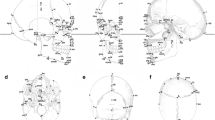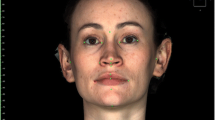Abstract
Objective:
The objective of this study was to analyze the reliability of a landmark-independent method for determining the facial symmetry plane and degree of asymmetry based on three-dimensional data from the facial surface from two sets of recordings, one performed consecutively and one performed on different days.
Materials and Methods:
We used an optical 3D-sensor to obtain the facial data of one male subject in two sets of ten measurements: the first taken consecutively and the second on different days. The symmetry plane and degree of asymmetry were calculated for each of the resulting twenty sets of data. One set of data was analyzed ten times for control purposes. The calculation of the mean deviation angle between the symmetry planes served as a measure of the reproducibility of these results.
Results:
Although the mean angular deviations of the computed symmetry planes, 0.134° (for ten consecutively captured images) and 0.177° (for the ten images captured on different days), were each significantly higher than the mean angular deviation (0.028°) calculated from ten analyses of a single image, they can still be regarded as very small. There were no significant differences in the degree of asymmetry among the three measurement sets. The standard deviations revealed low values.
Conclusions:
This method can be used to compute with high reliability the symmetry planes and degree of asymmetry of facial 3D-data. The color-coded visualization of asymmetrical facial regions makes it possible for this analytical procedure to capture the asymmetries of facial soft tissue with substantially greater precision than 2-dimensional en face images.
Zusammenfassung
Zielsetzung:
Ziel der vorliegenden Untersuchung war es, die Reliabilität einer landmarkenunabhängigen Methode zur Berechnung der Gesichtssymmetrieebene und des Asymmetriegrades bei aufeinanderfolgenden beziehungsweise an verschiedenen Tagen durchgeführten 3-D-Aufnahmen zu analysieren.
Material und Methodik:
Die 3-D-Gesichtsdaten eines männlichen Probanden wurden mit einem optischen Sensor erfasst. Es wurden zehn Aufnahmen direkt nacheinander sowie an verschiedenen Tagen durchgeführt, für welche jeweils die Symmetrieebene und der Asymmetriegrad berechnet wurden. Zusätzlich wurde eine Aufnahme zehnmal ausgewertet. Die Berechnung der mittleren Winkelabweichung zwischen den Symmetrieebenen diente als Maß für die Reproduzierbarkeit der Methode.
Ergebnisse:
Die mittlere Winkelabweichung der berechneten Symmetrieebenen war mit 0,134° (zehn Aufnahmen nacheinander) und 0,177° (zehn Aufnahmen an verschiedenen Tagen) zwar signifikant höher als bei zehnmaliger Auswertung derselben Aufnahme (0,028°), ist jedoch als sehr gering zu bewerten. Bezüglich des Asymmetriegrades gab es keine statistisch signifikanten Unterschiede zwischen den drei Auswerteserien, die jeweiligen Standardabweichungen waren gering.
Schlussfolgerungen:
Mit Hilfe der vorgestellten Methode können reproduzierbar die Symmetrieebene sowie der Asymmetriegrad anhand von 3-D-Gesichtsdaten bestimmt werden. Durch die farbkodierte Visualisierung von asymmetrischen Gesichtsbereichen ermöglicht dieses Analyseverfahren eine wesentlich präzisere Diagnostik von Asymmetrien der Gesichtsweichteile als zweidimensionale En-face-Aufnahmen.
Similar content being viewed by others
Author information
Authors and Affiliations
Corresponding author
Rights and permissions
About this article
Cite this article
Hartmann, J., Meyer-Marcotty, P., Benz, M. et al. Reliability of a Method for Computing Facial Symmetry Plane and Degree of Asymmetry Based on 3D-data. J Orofac Orthop 68, 477–490 (2007). https://doi.org/10.1007/s00056-007-0652-y
Received:
Accepted:
Issue Date:
DOI: https://doi.org/10.1007/s00056-007-0652-y




